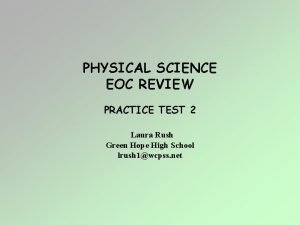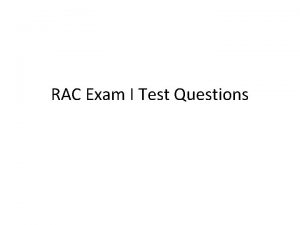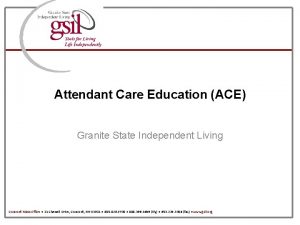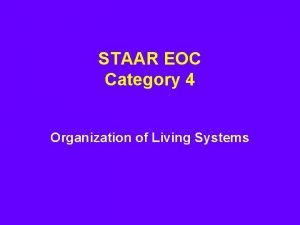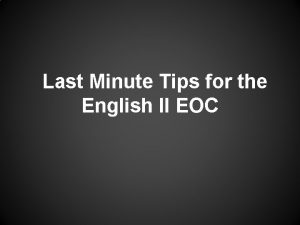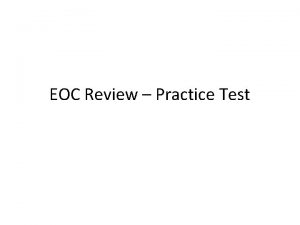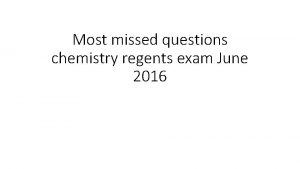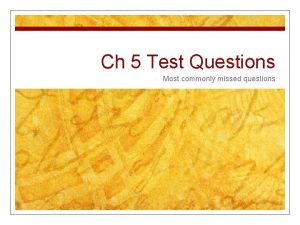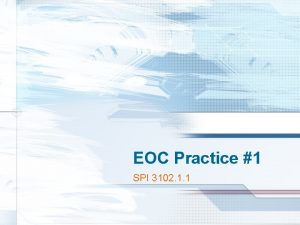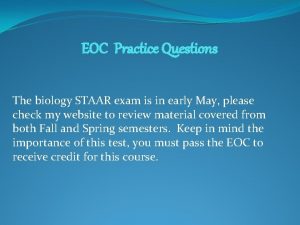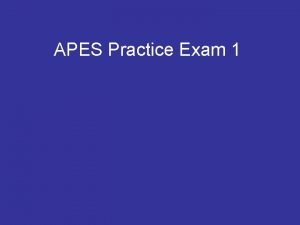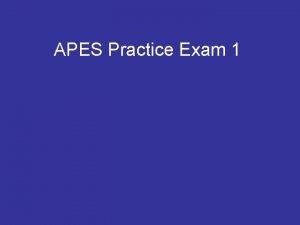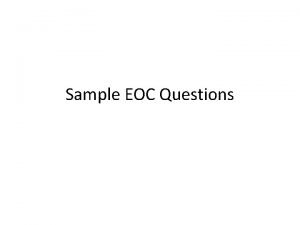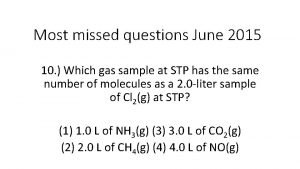EOC PRACTICE EXAM MOST MISSED QUESTIONS 2 A




























- Slides: 28

EOC PRACTICE EXAM MOST MISSED QUESTIONS

2. A person with swollen gums rinses his mouth with warm salt water, and the swelling decreases. Which has occurred? A. The swollen gums have absorbed the saltwater solution B. The saltwater solution lowers the temperature of the water in the gums C. The salt in the solution has moved against the concentration gradient D. The water in the gums ahs moved from a high to low concentration of water D. The water in the gums has moved from a high to low concentration of water

3. Which organelle is the site where amino acids are synthesized into proteins? A. 1 2 B. 2 1 4 3 C. 3 D. 4 B. 2… RIBOSOMES are where proteins are made…they can be attached to the endoplasmic reticulum

ANSWERS TO QUESTIONS 1 -9 1. B 4. D 7. C 2. D 5. A 8. C 3. B 6. D 9. B

10. What process produces many variations in phenotype? A. Independent assortment B. Asexual reproduction C. Regeneration D. cloning A independent assortment

INDEPENDENT ASSORTMENT…each chromosome separates independently of other chromosome pairs

11. One parent has PKU (phenylketonuria), which is caused by recessive alleles. The other parent does not have PKU alleles. What is the chance that the couple will have a child with PKU? A. 0% B. 50% C. 25% D. 100% P P Parent with PKU would have to be homozygous Recessive… pp p Pp Pp Parent without PKU alleles Would have to be homozygous Dominant… PP p Pp Pp A…O%

14. Which plant is most likely a gymnosperm? plant Vascular tissue Seeds 1 X 2 X Flowers cones X X 3 4 X X X A. PLANT 1 because it contains cones… A. Plant 1 B. Plant 2 C. Plant 3 D. Plant 4 Gymnosperms contain cones Angiosperms produce flowers Ferns are vascular plants that don’t produce seeds Nonvascular plants (like mosses) don’t have vascular tissue (xylem & phloem)

16. If the xylem in a young tree is damaged, which process is first affected? A. Performing photosynthesis B. Transporting sugar to roots C. Transporting water to the leaf D. Absorbing water from the soil

17. A plant species lives in an area with limited sunlight. Which adaptation would be most useful to the plant? A. Colorful flowers B. Large leaves C. Deep roots D. Thin cuticle A. LARGE LEAVES

20. Which substance is considered to be a factor affecting the Earth’s ozone layer? A. Chlorofluorocarbon s (CFCs) B. Ethyl alcohol C. Nitrogen gas A. chloroflurocarbons D. Water vapor

ANSWERS TO QUESTIONS 10 -20 10. A D 14. A 18. 11. A 15. C 19. B 12. C 16. C 20. A 13. D 17. B

24. What is represented by A? A. Substrate B. Product C. Enzyme D. complex A. Substrate…. notice “A” changes by end of reaction…. structure B/C/D is the enzyme & does not change throughout the reaction

25. Two different species of bacteria are examined. Scientists find that Species X always produces CO 2 and H 20 during cellular respiration. Species Y always produces ethyl alcohol and Co 2. A. Only species Y is aerobic B. Only species Y is anaerobic C. Both species X & Y are aerobic D. Both species X & Y are anaerobic Which conclusion can be made from these observations? B. Only species Y is anaerobic

29. Which is a used of genetically engineered bacteria? A. Identifying the remains of an unknown person B. Developing a DNA fingerprint for blood left at a crime scene C. Making human insulin for diabetes D. Producing corn that is resistant to herbicides C. Making human insulin for diabetes

ANSWERS TO QUESTIONS 21 -31 21. C 25. B 29. C 22. C 26. B 30. B 23. D 27. A 24. A 28. A 31. D

36. After initial infection, B cells recognize the measles virus. How is this helpful in the human immune response? A. The B cells use this recognition to defend the body against other pathogens, such as bacteria B. The B cells more quickly recognize & respond to any other virus that invades the body C. The B cells produce antibodies more quickly if the measles virus is encountered again D. The B cells transfer this recognition to Tcells, which will then devour the viruses. C. The B cells produce antibodies more quickly if the measles virus is encountered again

39. A scientist performs an experiment to see if acid rain have an effect on the health of a particular type of plant. Threes sets of plants werw treates with acidic solutions of known p. H while the control set was treated with a solution of neutral p. H 7 A. Acid has no effect on the health of this type of plant B. High acidity is helpful to this type of plant C. Low acidity is harmful to this type of plant D. High acidity is harmful to this type of plant

C. Low acidity is harmful to this type of plant All 10 plants are dead at p. H of 2 No plants died at p. H of 7. No evidence that high p. H is helpful…we just see that plants did not die at the higher p. Hs

ANSWERS TO QUESTIONS 32 -40 32. A 35. D 33. D 36. C 34. B 37. B 38. A 39. C 40. C

50. A cloned plant has a diploid chromosome number of 12. what is the diploid chromosome number of the plant cell that was used to produce the cloned plant? A. 6 B. 12 C. 18 A. 12 D. 24

ANSWERS TO QUESTIONS 41 -50 41. D 45. D 42. A 46. C 43. B 47. A 44. C 48. D 49. D 50. B

51. Due to independent assortment, what is the possible genetic make up of gametes produced by this organism A. Ss. Tt B. Ss, Tt C. S, s, T, t D. ST, St, s. T, st

57. Which sequence shows increasing ecological levels of organization? A. Organism…population…community… ecosystem B. Ecosystem…population…organism. . . community C. Community…ecosystem…population … organism D. Population…organism…ecosystem… community

A. Organism: population: community: ecosystem

60. What will most likely happen if decomposers are removed from the carbon cycle? A. The amount of carbon dioxide in the atmosphere will increase B. The amount of carbon dioxide in the atmosphere will decrease C. The amount of carbon dioxide used by producers will increase D. The amount of carbon dioxide needed by consumers will decrease

B. The amount of carbon dioxide in the atmosphere will decrease Decomposition released carbon dioxide into the atmosphere… So if decomposers are removed… no decomposition… less carbon dioxide going into atmosphere

ANSWERS TO QUESTIONS 51 -60 51. D 55. C 58. B 52. C 56. C 59. B 53. A 57. A 60. B 54. C
 Civics eoc exam
Civics eoc exam Science eoc review
Science eoc review Hbs eca study guide
Hbs eca study guide Civics eoc practice
Civics eoc practice Abfm study guide
Abfm study guide Rac practice exam
Rac practice exam Welcome home we missed you
Welcome home we missed you Paylocity training
Paylocity training Missed some points on the visual field test for dvla
Missed some points on the visual field test for dvla Gsil missed punch
Gsil missed punch We missed you welcome back
We missed you welcome back O romeo, romeo
O romeo, romeo Romeo o romeo
Romeo o romeo Missed connections arlington va
Missed connections arlington va Gsil missed punch form
Gsil missed punch form How to fix a missed punch in kronos 2020
How to fix a missed punch in kronos 2020 Cisco ip phone 7965 voicemail
Cisco ip phone 7965 voicemail Florida us history eoc review
Florida us history eoc review Pbs eoc review
Pbs eoc review Gilded age eoc blitz review
Gilded age eoc blitz review Us history eoc review notebook
Us history eoc review notebook This area along the german/belgian border was demilitarized
This area along the german/belgian border was demilitarized 11 grade us history eoc review
11 grade us history eoc review Things to know for biology eoc
Things to know for biology eoc Tips for staar writing test
Tips for staar writing test The teapot dome scandal centered around *
The teapot dome scandal centered around * Youtub.eoc
Youtub.eoc Physical science eoc review
Physical science eoc review English eoc tips
English eoc tips

